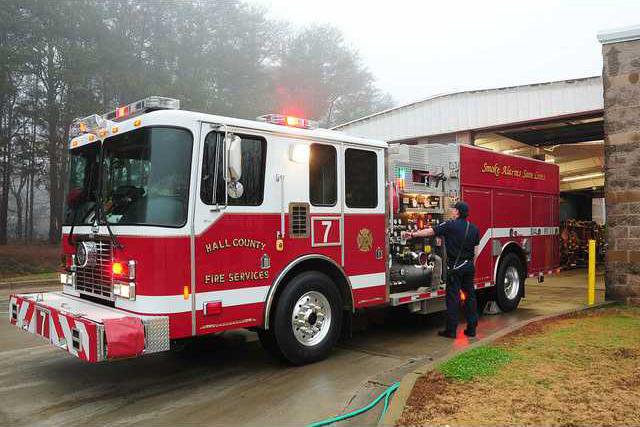Firefighters have plenty of dangers to worry about on the job: falling debris, explosions and high levels of heat. But recent studies reveal additional health concerns.
Both studies were conducted by University of Georgia researchers in the College of Public Health. The most recent of the two discovered declines in lung function in firefighters working at prescribed burns.
But another study reveals that heart attacks, not smoke inhalation, is the most common cause of death in firefighters.
"The stress of the amount of work you're doing while fighting a fire is tremendous on the body," Gainesville Fire Chief Jon Canada said.
Similar to the shock of jumping in freezing water, the stress levels on the heart associated with fighting a fire can be high.
"Firefighters go from, basically, zero to 60 in just a matter of seconds," Canada said. "You're body is reacting to that so it does put a tremendous amount of stress on your body."
Hall County Fire Chief David Kimbrell said firefighters typically adjust to the increased stress levels, but the long-term health effects could be significant.
Prescribed burning is a technique used in forest management to reduce chances of a more serious forest fire. Such burns are often worked without the use of breathing apparatuses.
Hall County firefighters seldom work prescribed burns, but do so on occasion. Because the county doesn't have an extensive area of forestry, they are usually smaller and are considered grass fires.
"In those situations, our guys are not wearing breathing apparatuses because it's so open," Kimbrell said. "If the smoke turns toward them, they can walk a few feet out of the way and get out of it."
At times Hall County firefighters have been contracted by forestry services to assist with wildfires in South Georgia. Forestry services have their own regulations concerning the amount of hours firefighters are permitted to work. That regulation is a 2 to 1 ratio, meaning eight hours of work must be followed by four of rest.
Gainesville Fire Department also has requirements regarding successive shifts. Any firefighter working a shift longer than 48 hours requires the approval of Canada in advance.
"It's a rarity that anybody works over that 48 hours," he said.
Even with regulations, firefighter safety continues to be a concern. Firefighter deaths decreased in the 1970s and 1980s, primarily due to improved equipment. Since then, fatalities have increased slightly while the number of fires has dropped, according to the study.
Even with the improved protective clothing and breathing equipment, firefighters are exposed to smoke that often contains toxic chemicals.
"No matter how well you're protected, you're still exposed to that," Canada said.
Those chemicals lead to higher numbers of firefighters diagnosed with cancer, Kimbrell said.
Because many fire scenes do have a high number of such materials, Kimbrell now requires firefighters to wear their breathing apparatuses even after the fire has been put out and crews are checking the scene.
"There's still a tremendous amount of combustion by-products in the air," he said.
The protective equipment, though, can also lead to muscular injuries involving shoulders, back and knees.
"That goes with the job. Sometimes you strain, pull or twist the wrong way with equipment," Canada said. "But the fire services have come a long way in making firefighters healthier and trying to provide a safer environment."
When working a fire, crews are rotated to have vital signs checked and take time to rehydrate before going back to work.
Local fire departments encourage firefighters to exercise regularly to accustom their bodies to increased heart rates and handle the physical stress.
Canada said it's imperative for firefighters to stay in peak physical condition to handle the various conditions they will encounter.
"If you're not you can't do it," he said. "Our firefighters are very good about working out and doing (cardiovascular) exercise because that's really where their strength comes in."
Safety equipment and techniques are constantly improving and fire officials attempt to keep up with those changes.
"We feel like we're pretty safety conscious and we try to do everything that we can because our folks are our No. 1 asset," Kimbrell said. "You can replace a car or a truck, but our folks are our No. 1 resource."

